With so much emphasis on lure fishing, CRAIG McGILL reckons it’s time to refocus on just how good bait can be.
SECTION: feature P 6, 7
MAPS:
Facts
ILLUSTRATIONS: 0
You will hear all sorts of different interpretations as to what's the most important aspect of fishing success. Some think it’s line, others say it’s hooks or high-tech rods and reels. The bottom line is that the quality of the bait determines whether or not your hook is going into the fish’s mouth.
Bait is the vehicle that takes the hook into the fish’s mouth. If the fish rejects it, then it will lie on the bottom and it doesn't matter how expensive or high-tech the rest of the outfit is, there will be no fish on the line.
A bait might get taken for a number of reasons. Smell or taste is one, another is movement. For example, does a flathead take a prawn bait on the drift because it's moving or because it smells like food? A flathead will take a lure bounced along the bottom and it has no smell or taste. Therefore a natural bait’s presentation must be taken into consideration when concluding why a fish might have taken it.
On the other hand, take for example lures like the Berkley Power Bait range of soft plastics. They are primarily designed as a lure but I know for a fact that fish will take them as bait if they are left to sit on the bottom. Are they a bait or a lure? This is an issue that will surely come to a head as the popularity and prizemoney of lure fishing tournaments peaks
We can assume that an unscented lure has been hit because of its movement but we can’t always assume that a natural bait has been taken because of smell. There's no denying, though, that a bait is very often taken because of its initial smell. I am trying to highlight the importance of bait presentation.
Assuming that a fish can be coaxed into taking a bait on presentation alone, there's no denying that once it is in the fish’s mouth that smell and taste come into play. An artificial bait with no scent will be rejected almost immediately.
A natural bait will be rejected on a time scale in proportion with its acceptability to the fish. Stale baits will go first; right through to a point where the bait is fresh enough for the fish to decide to swallow it. Fresh or live bait is therefore the obvious choice.
In summary, it’s all very simple:
• Presentation is very important. Your bait might be taken on presentation alone, especially by predatory fish. Presentation doesn't just mean the way the bait is put on the hook, it also refers to the way it is presented in the water – moving, floating or fixed.
• Fresh bait is important for both the initial attraction and its acceptance once taken.
• Live bait is the ultimate. Providing it is presented properly, live bait offers the best in sensory attraction. It's wriggling, throwing off reflection and vibration. It might even be kicking up sand or mud offering further visual attraction. Once it's taken, it feels right, it smells and tastes right because it is right.
Most of the frozen packet stuff you buy, with the exception of things like gut and fillets, can be obtained one way or another in its live state. It’s exactly the same creature as in its frozen form but infinitely more effective.
Availability of live baits through tackle and bait outlets is sparse. The cost of collecting and then maintaining live bait is the limiting factor.
Prawns and shellfish are commonly available live through the fish markets, thanks to the needs of our ever-growing Asian population. Livies available through tackle and bait outlets include worms (beach, blood and squirt ) and nippers or yabbies. If you want anything else live, you will have to catch it yourself.
Most of our rivers, estuaries and especially lakes have prawn stocks to some degree. They are gathered at night using a bright torch and a scoop net or a drag net.
They keep well in an aerated bucket or in wet ribbon weed or sawdust. Keeping live prawns cool is very important. Live prawns are the ultimate estuary bait and will take virtually every species. To hook a prawn, a No 4 to 1/0 hook, depending on the size of the bait, is pushed up from underneath the last segment towards the tail and out through the top of the shell so the barb is exposed.
Yabbies are found in the sandbanks towards the lower reaches of rivers and estuaries.
The only practical method of extracting them is with a yabby pump. I've had an Alvey pump for over 20 years and have replaced the washers only once for only a few dollars. We bought it for about $15 and over the years have pumped probably thousands of dollars’ worth of bait. They also work on squirt worms so you can see they are well worth the investment.
Yabbies are kept alive in much the same way as prawns. They are pinned on a No 4 to 1/0 baitholder-pattern hook by pushing the hook along the body, starting from the tail, until it reaches the eye of the hook. The point and barb should come out on the underside of the yabby.
The most effective live fish baits include yellowtail, garfish, mullet and herring. If you’re living in a part of the country where castnets are legal – it is illegal to possess a castnet within a prescribed distance of water in NSW – then they are a very worthy investment and once you've mastered them are highly effective method of collecting live bait.
In other areas a good berley trail, light line and a No 12 hook will do the job. Alternatively, for mullet, a bait trap baited with bread is highly effective.
Livies are best kept alive in a container of aerated water with regular water changes necessary for prolonged life. Boat or jetty anglers could also employ the bucket-in-a-bucket technique with a number of holes drilled in the smaller bucket, which just fits inside the larger one. You replace the water in the larger bucket while the baitfish are retained in the smaller one. There are a number of commercially-made models of livie buckets, the smaller ones of which can also work well for prawns or yabbies.
Hook size varies greatly with the size of the bait and could range anywhere between 1/0 and 8/0.
Hook placement depends on how the bait is to be fished. If it is to be fished under a float then it is best placed through the shoulders just behind the head.
If it's to be free-swimming unweighted or anchored to the bottom, the hook is best pushed through the body just ahead of the tail.
In both cases the hook must not penetrate the fish’s lateral line, which approximates the position of the backbone. It runs the length of the fish and on bait species especially, is quite prominent. Penetrate the fish’s backbone and your livie soon becomes a dead bait.
Squid are one of the estuary’s top live baits for big predatory fish. They make a pretty mediocre bait as dead bait.
The best way to catch them is with a squid jig fished slowly around the kelp or ribbon weed beds somewhere near deep water.
They are very hard to keep alive but high aeration, plenty of water changes and room to swim are the keys.
As with live fish, the hook size varies according to the squid size. They are pinned around the middle of the tube, being careful not to pierce the intestines.
The major two bait worms used in the estuary are bloodworms and squirt worms.
Squirt worms are found on the sandbanks well upstream towards a waterway’s freshwater reaches. They are best extracted by using your yabby pump to pump sand into a fine-gauge sieve. You can also place a empty jam tin over their U-shaped hole and stamp on it, forcing the worm out the other entrance, but I prefer pumping. You can achieve the same result as the jam tin by pumping air into the hole with your yabby pump, anyway.
Bloodworms like the firmer mud areas upstream around mangroves and weed beds. The only effective way to extract them is to dig them out. This is a fairly destructive practice and large-scale digging on Sydney Harbour foreshores eventually forced it to be banned in that area.
Bloodworms keep for short periods in a well aerated container of water or, for longer periods, in a box layered with hessian.
The bottom of the box is perforated to allow water to drain, then a layer of hessian is placed on the bottom. The worms are placed on the hessian and another layer of hessian is placed over the top of them. Store them under the house where it is cool and dark and periodically pour water, taken from where you caught the worms, over the top layer of hessian so it rinses them and then drains out the bottom.
These worms are threaded lengthwise along the hook until a bunch forms. The remaining worm is then nipped off about 3cm below the hook, leaving a small length waving about enticingly. Hook size varies from a No 8 to 1/0, depending on species.
Lately commercially grown tube worms have become available through selected bait outlets and these can be stored and baited up in similar fashion.
I always buy big frozen prawns and I have found none better than the big Hawkesbury prawns packaged by Bellissimo Bait. They are essential if you want to consistently catch soapy jewfish up to 3kg.
If they are too big for bream, cut them in half or, for the likes of leatherjackets, into smaller pieces. A 400g packet is usually adequate for a day’s outing.
The hook is fed along the body, starting at the tail, with the point protruding out from underneath. It is very important that the prawn’s body lies straight along the hook. Good quality prawns are the next-best estuary bait to live bait.
If you buy Hawkesbury prawns then you are in no position to protest against trawling. By buying their produce you effectively become a sponsor of this highly destructive and unsustainable industry.
The two common gut baits come from mullet and chickens. Chicken gut is often marketed under the brand name Fisho. Both guts are readily available and cheap and make a convenient bait.
The gut is cut into lengths about 8cm long and threaded on in the same manner as a worm, with a short length trailing free.
Whole fish or fillets can be purchased packaged or caught yourself. There a number of ways to use fish flesh.
Fish such as whitebait and pilchards can be used whole, either on a single or ganged hooks.
Fillets of fish like yellowtail, pilchards, mullet and slimy mackerel make very attractive baits by threading the hook through the tail end of the fillet so that the hook comes out with the barb on the flesh side. Fillets of much larger fish, like tuna and tailor, can be cut into smaller baits by cutting across the fillet widthways and feeding the hook through so, once again, the barb comes out on the flesh side.
Tougher flesh fish like trevally, yellowtail and the tail ends of tuna make excellent flesh baits by skinning the fillet and cutting the flesh into cubes or long thin pieces
Cabbage and hair weed collected on the ocean rocks or the fine-stranded weed found in the upper reaches of rivers and estuaries (especially Parramatta weed) is used primarily for the capture of estuary blackfish.
It's easy to collect once located and easy to keep. It will last for about two weeks kept in a damp hessian sack in the fridge, or for months by putting it in an ice-cream container, covering it in water and freezing it. When you want to use it just place it in a bucket of water until it thaws.
Cabbage weed is threaded on and hair or strand weed is plaited on a No 10 or No 8 hook.
There are heaps of other live and packaged baits used in the estuary but these are the most common and the most successful.

A live squid just waits to be scoffed down. Note how the hook is placed to keep the bait as lively as possible without damaging the cephalopod.
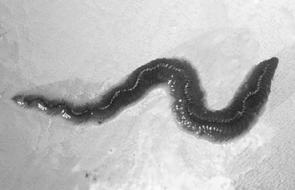
They take a bit of work to find and pump but squirt worms are juicy morsels that all estuary fish find irresistible. They present best on a fine-gauge hook.
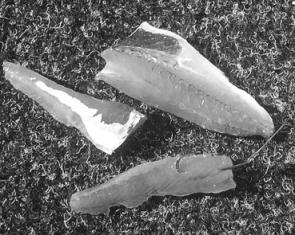
A strip or fillet of fresh fish bait oozes with natural juices and enzymes that just can’t be duplicated by the frozen product or any soft plastic scent.

Estuary predators such as this quality flathead are complete suckers for live poddy mullet, easily gathered with a bait trap or small hook and a few slices of fresh white bread.
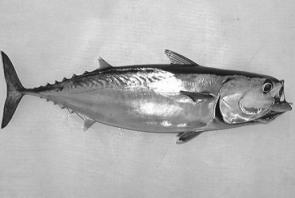
Frigate mackerel are heaps of fun to catch on light tackle and are superb live bait for offshore predators and excellent in fillets or strips for a whole host of species.
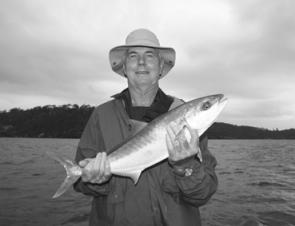
When it comes to catching kingfish, nothing gets them into feeding mode better than live squid. Period.
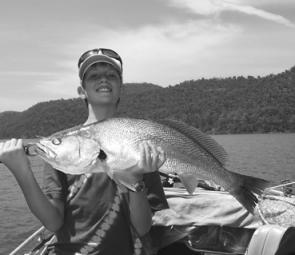
Top-order estuary predators like jewfish are fond of any live bait, be it a prawn, worm, poddy mullet or squid.

A live yellowtail ready to be floated out. Note the hook placement behind the head and well away from the spine and the lateral line.




